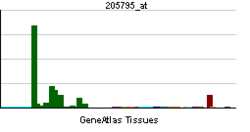NRXN3
| View/Edit Human | |||
Neurexin-3-alpha is a protein that in humans is encoded by the NRXN3 gene.[3][4][5]
Neurexins are a family of proteins that function in the vertebrate nervous system as cell adhesion molecules and receptors. They are encoded by several unlinked genes of which two, NRXN1 and NRXN3, are among the largest known human genes. Three of the genes (NRXN1-3) utilize two alternate promoters and include numerous alternatively spliced exons to generate thousands of distinct mRNA transcripts and protein isoforms. The majority of transcripts are produced from the upstream promoter and encode alpha-neurexin isoforms; a much smaller number of transcripts are produced from the downstream promoter and encode beta-neurexin isoforms. The alpha-neurexins contain epidermal growth factor-like (EGF-like) sequences and laminin G domains, and have been shown to interact with neurexophilins. The beta-neurexins lack EGF-like sequences and contain fewer laminin G domains than alpha-neurexins.[5] NRXN3 is thought to be involved in synaptic plasticity, and polymorphisms in NRXN3 have been linked to genetic predisposition towards a number of conditions such as alcohol or drug addiction,[6][7][8] or obesity.[9]
References
- ↑ "Diseases that are genetically associated with NRXN3 view/edit references on wikidata".
- ↑ "Human PubMed Reference:".
- ↑ Rowen L, Young J, Birditt B, Kaur A, Madan A, Philipps DL, Qin S, Minx P, Wilson RK, Hood L, Graveley BR (Apr 2002). "Analysis of the human neurexin genes: alternative splicing and the generation of protein diversity". Genomics. 79 (4): 587–97. doi:10.1006/geno.2002.6734. PMID 11944992.
- ↑ Occhi G, Rampazzo A, Beffagna G, Antonio Danieli G (Oct 2002). "Identification and characterization of heart-specific splicing of human neurexin 3 mRNA (NRXN3)". Biochem Biophys Res Commun. 298 (1): 151–5. doi:10.1016/S0006-291X(02)02403-8. PMID 12379233.
- 1 2 "Entrez Gene: NRXN3 neurexin 3".
- ↑ Lachman HM, Fann CS, Bartzis M, Evgrafov OV, Rosenthal RN, Nunes EV, Miner C, Santana M, Gaffney J, Riddick A, Hsu CL, Knowles JA (June 2007). "Genomewide suggestive linkage of opioid dependence to chromosome 14q". Human Molecular Genetics. 16 (11): 1327–34. doi:10.1093/hmg/ddm081. PMID 17409192.
- ↑ Hishimoto A, Liu QR, Drgon T, Pletnikova O, Walther D, Zhu XG, Troncoso JC, Uhl GR (December 2007). "Neurexin 3 polymorphisms are associated with alcohol dependence and altered expression of specific isoforms". Human Molecular Genetics. 16 (23): 2880–91. doi:10.1093/hmg/ddm247. PMID 17804423.
- ↑ Kelai S, Maussion G, Noble F, Boni C, Ramoz N, Moalic JM, Peuchmaur M, Gorwood P, Simonneau M (May 2008). "Nrxn3 upregulation in the globus pallidus of mice developing cocaine addiction". NeuroReport. 19 (7): 751–5. doi:10.1097/WNR.0b013e3282fda231. PMID 18418251.
- ↑ Heard-Costa NL, Zillikens MC, Monda KL, Johansson A, Harris TB, Fu M, Haritunians T, Feitosa MF, Aspelund T, Eiriksdottir G, Garcia M, Launer LJ, Smith AV, Mitchell BD, McArdle PF, Shuldiner AR, Bielinski SJ, Boerwinkle E, Brancati F, Demerath EW, Pankow JS, Arnold AM, Chen YD, Glazer NL, McKnight B, Psaty BM, Rotter JI, Amin N, Campbell H, Gyllensten U, Pattaro C, Pramstaller PP, Rudan I, Struchalin M, Vitart V, Gao X, Kraja A, Province MA, Zhang Q, Atwood LD, Dupuis J, Hirschhorn JN, Jaquish CE, O'Donnell CJ, Vasan RS, White CC, Aulchenko YS, Estrada K, Hofman A, Rivadeneira F, Uitterlinden AG, Witteman JC, Oostra BA, Kaplan RC, Gudnason V, O'Connell JR, Borecki IB, van Duijn CM, Cupples LA, Fox CS, North KE (June 2009). Dermitzakis ET, ed. "NRXN3 Is a Novel Locus for Waist Circumference: A Genome-Wide Association Study from the CHARGE Consortium". PLoS Genetics. 5 (6): e1000539. doi:10.1371/journal.pgen.1000539. PMC 2695005
 . PMID 19557197.
. PMID 19557197.
Further reading
- Olsen JV, Blagoev B, Gnad F, et al. (2006). "Global, in vivo, and site-specific phosphorylation dynamics in signaling networks". Cell. 127 (3): 635–48. doi:10.1016/j.cell.2006.09.026. PMID 17081983.
- Kimura K, Wakamatsu A, Suzuki Y, et al. (2006). "Diversification of transcriptional modulation: Large-scale identification and characterization of putative alternative promoters of human genes". Genome Res. 16 (1): 55–65. doi:10.1101/gr.4039406. PMC 1356129
 . PMID 16344560.
. PMID 16344560. - Ota T, Suzuki Y, Nishikawa T, et al. (2004). "Complete sequencing and characterization of 21,243 full-length human cDNAs". Nat. Genet. 36 (1): 40–5. doi:10.1038/ng1285. PMID 14702039.
- Heilig R, Eckenberg R, Petit JL, et al. (2003). "The DNA sequence and analysis of human chromosome 14". Nature. 421 (6923): 601–7. doi:10.1038/nature01348. PMID 12508121.
- Strausberg RL, Feingold EA, Grouse LH, et al. (2003). "Generation and initial analysis of more than 15,000 full-length human and mouse cDNA sequences". Proc. Natl. Acad. Sci. U.S.A. 99 (26): 16899–903. doi:10.1073/pnas.242603899. PMC 139241
 . PMID 12477932.
. PMID 12477932. - Tabuchi K, Südhof TC (2002). "Structure and evolution of neurexin genes: insight into the mechanism of alternative splicing". Genomics. 79 (6): 849–59. doi:10.1006/geno.2002.6780. PMID 12036300.
- Nagase T, Ishikawa K, Suyama M, et al. (1999). "Prediction of the coding sequences of unidentified human genes. XI. The complete sequences of 100 new cDNA clones from brain which code for large proteins in vitro". DNA Res. 5 (5): 277–86. doi:10.1093/dnares/5.5.277. PMID 9872452.
- Hock B, Böhme B, Karn T, et al. (1998). "PDZ-domain-mediated interaction of the Eph-related receptor tyrosine kinase EphB3 and the ras-binding protein AF6 depends on the kinase activity of the receptor". Proc. Natl. Acad. Sci. U.S.A. 95 (17): 9779–84. doi:10.1073/pnas.95.17.9779. PMC 21413
 . PMID 9707552.
. PMID 9707552. - Nagase T, Ishikawa K, Miyajima N, et al. (1998). "Prediction of the coding sequences of unidentified human genes. IX. The complete sequences of 100 new cDNA clones from brain which can code for large proteins in vitro". DNA Res. 5 (1): 31–9. doi:10.1093/dnares/5.1.31. PMID 9628581.
- Hata Y, Butz S, Südhof TC (1996). "CASK: a novel dlg/PSD95 homolog with an N-terminal calmodulin-dependent protein kinase domain identified by interaction with neurexins". J. Neurosci. 16 (8): 2488–94. PMID 8786425.
- Ichtchenko K, Nguyen T, Südhof TC (1996). "Structures, alternative splicing, and neurexin binding of multiple neuroligins". J. Biol. Chem. 271 (5): 2676–82. doi:10.1074/jbc.271.5.2676. PMID 8576240.
- Ushkaryov YA, Petrenko AG, Geppert M, Südhof TC (1992). "Neurexins: synaptic cell surface proteins related to the alpha-latrotoxin receptor and laminin". Science. 257 (5066): 50–6. doi:10.1126/science.1621094. PMID 1621094.


